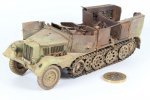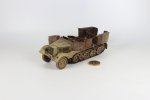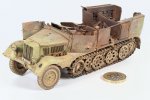Panzerwrecker
SMF Supporter
- Joined
- Mar 2, 2022
- Messages
- 362
- Points
- 93
- First Name
- Los
Photo Stacking
If you’ve never used this process, it’s well worth looking into. I recently read an article by a well-respected modeller on FB on how he had achieved some great results with a dedicated app. This modeller was well versed in taking great images already, but this was his first attempt at photo stacking. His results were spectacular.
What is photo stacking? Essentially it is a technique that allows photographers to create a single image where objects on various focal planes are all in focus. As the software app company Zerene Stacker explains ‘The idea of focus stacking is simple: you just shoot multiple pictures focused on different depth planes, rummage through the stack to "find all the sharp bits", then piece those bits together into a single image that shows the best parts of the whole stack. It's an old technique, dating back to scissors and glue. But modern computers and digital cameras take focus stacking to a whole new level, automatically stacking tens or hundreds of frames to make astounding images from landscapes to microscopy that you could never capture in a single shutter click.’
See here for more info: https://digital-photography-school.com/a-beginners-guide-to-focus-stacking/
Whilst I understand that some photo editing software does include this option, the dedicated software that this FB modeller found looks to be one of the best at performing this task. It is subscription based but they offer a free 30-day trial so check it out to see if it is something that can improve your photography experience. To download the software, see: https://zerenesystems.com/cms/stacker
What do you need?
TBH I’m a real novice when it comes to digital photography. I just can’t seem to retain the information that is necessary for good consistent results. I do have a shortlist of settings that should deliver me good results, but I still manage to trip myself up. I have a Canon EOS 600D and shoot my models in Av (aperture priority AE) mode so I can manually set the aperture (f/number). For this exercise I set it to F/22 with the ISO set to 200. Setting the white balance is essential and although the camera’s software can correct it, it is always worth setting it up from the get-go.
I downloaded the Zerene software to my PC, chose a subject, and set up my camera on a tripod. I have limited space in my mancave, so I just have a tabletop set up which includes two adjustable LED lights with a white PVC backdrop on its own table stand. These were all purchased from: https://www.essentialphoto.co.uk/
An old 1/35 AFV Club Sd.Kfz 11 build was my chosen subject.
I am still reading up on the best way to take numerous images with both the subject and the camera remaining completely static, but for this first attempt I simply turned the lens focal ring by hand. Again, unsure of where I would focus the first shot I simply positioned the camera so I could frame the vehicle at its shortest focal length. I have no macro lens so with the standard 18-55mm Canon lens I then took thirteen separate images, with the self-timer set at 10secs to maximise stabilisation, adjusting the focus manually at even intervals until I reached the camera’s maximum focal length. If you can hook up your camera to a PC, you could shoot without touching the camera at all and I’m pretty sure there will be ways to automatically take multiple images at different focal lengths too.
I then saved my 13 RAW images to my camera's own editing software. The Zerene Stacker software cannot edit RAW images, so I converted and saved all 13 images to JPG format. I then copied and paste the JPG images to the Zarene software. These all appear in the software as input files. Then it’s just a simple case of clicking ‘stack’ then ‘Align and stack all (PMax)’ and you watch the software do its thing. Each of the 13 individual images are cycled and displayed on the left of the screen as they are analysed, and the retouched image is updated on the right of the screen until they are all uploaded. The final image file displays in an output file where you can save it individually or save the whole project. It really couldn’t be simpler. There is a retouching tool, but I have yet to look into this.
Below is the first image

This is the last image (13th in this case)

This is the photo stacked image I ended up with

There is a definate improvement in focus over the whole subject so this is something I will definately be adopting from now on.
Give it a go. if you can shoot great pics already then software like this is worth considering.
If you’ve never used this process, it’s well worth looking into. I recently read an article by a well-respected modeller on FB on how he had achieved some great results with a dedicated app. This modeller was well versed in taking great images already, but this was his first attempt at photo stacking. His results were spectacular.
What is photo stacking? Essentially it is a technique that allows photographers to create a single image where objects on various focal planes are all in focus. As the software app company Zerene Stacker explains ‘The idea of focus stacking is simple: you just shoot multiple pictures focused on different depth planes, rummage through the stack to "find all the sharp bits", then piece those bits together into a single image that shows the best parts of the whole stack. It's an old technique, dating back to scissors and glue. But modern computers and digital cameras take focus stacking to a whole new level, automatically stacking tens or hundreds of frames to make astounding images from landscapes to microscopy that you could never capture in a single shutter click.’
See here for more info: https://digital-photography-school.com/a-beginners-guide-to-focus-stacking/
Whilst I understand that some photo editing software does include this option, the dedicated software that this FB modeller found looks to be one of the best at performing this task. It is subscription based but they offer a free 30-day trial so check it out to see if it is something that can improve your photography experience. To download the software, see: https://zerenesystems.com/cms/stacker
What do you need?
- Any brand of digital camera and its software
- A camera tripod
- Not essential but ideally a lightbox, dedicated lighting with a backdrop.
- Desk or Laptop computer
TBH I’m a real novice when it comes to digital photography. I just can’t seem to retain the information that is necessary for good consistent results. I do have a shortlist of settings that should deliver me good results, but I still manage to trip myself up. I have a Canon EOS 600D and shoot my models in Av (aperture priority AE) mode so I can manually set the aperture (f/number). For this exercise I set it to F/22 with the ISO set to 200. Setting the white balance is essential and although the camera’s software can correct it, it is always worth setting it up from the get-go.
I downloaded the Zerene software to my PC, chose a subject, and set up my camera on a tripod. I have limited space in my mancave, so I just have a tabletop set up which includes two adjustable LED lights with a white PVC backdrop on its own table stand. These were all purchased from: https://www.essentialphoto.co.uk/
An old 1/35 AFV Club Sd.Kfz 11 build was my chosen subject.
I am still reading up on the best way to take numerous images with both the subject and the camera remaining completely static, but for this first attempt I simply turned the lens focal ring by hand. Again, unsure of where I would focus the first shot I simply positioned the camera so I could frame the vehicle at its shortest focal length. I have no macro lens so with the standard 18-55mm Canon lens I then took thirteen separate images, with the self-timer set at 10secs to maximise stabilisation, adjusting the focus manually at even intervals until I reached the camera’s maximum focal length. If you can hook up your camera to a PC, you could shoot without touching the camera at all and I’m pretty sure there will be ways to automatically take multiple images at different focal lengths too.
I then saved my 13 RAW images to my camera's own editing software. The Zerene Stacker software cannot edit RAW images, so I converted and saved all 13 images to JPG format. I then copied and paste the JPG images to the Zarene software. These all appear in the software as input files. Then it’s just a simple case of clicking ‘stack’ then ‘Align and stack all (PMax)’ and you watch the software do its thing. Each of the 13 individual images are cycled and displayed on the left of the screen as they are analysed, and the retouched image is updated on the right of the screen until they are all uploaded. The final image file displays in an output file where you can save it individually or save the whole project. It really couldn’t be simpler. There is a retouching tool, but I have yet to look into this.
Below is the first image

This is the last image (13th in this case)

This is the photo stacked image I ended up with

There is a definate improvement in focus over the whole subject so this is something I will definately be adopting from now on.
Give it a go. if you can shoot great pics already then software like this is worth considering.
Last edited:



